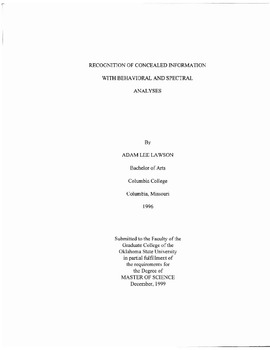| dc.contributor.author | Lawson, Adam Lee | |
| dc.date.accessioned | 2014-09-29T15:04:22Z | |
| dc.date.available | 2014-09-29T15:04:22Z | |
| dc.date.issued | 1999-12-01 | |
| dc.identifier.uri | https://hdl.handle.net/11244/11784 | |
| dc.description.abstract | The main thesis of this project was that individuals who have concealed information can be detected using a combined behavioral and psychophysiological approach. This study examined the similarities and differences that characterize the behavioral and power spectra responses in truthful and deceptive subjects. Half of the subjects participated in a mock crime while the other half participated in a non-crime scenario. The participants responded during their session to words related and not related to the scenarios they enacted. Although the participants in the crime group were instructed to deny anything related to their scenario, the behavioral and spectral data demonstrate that they actually possess concealed information. Therefore, behavioral and spectral indices elicited by concealed information in deceptive subjects can reflect some aspects of deceit. | |
| dc.format | application/pdf | |
| dc.language | en_US | |
| dc.publisher | Oklahoma State University | |
| dc.rights | Copyright is held by the author who has granted the Oklahoma State University Library the non-exclusive right to share this material in its institutional repository. Contact Digital Library Services at lib-dls@okstate.edu or 405-744-9161 for the permission policy on the use, reproduction or distribution of this material. | |
| dc.title | Recognition of Concealed Information with Behavioral and Spectral Analyses | |
| dc.type | text | |
| osu.filename | Thesis-1999-L425r.pdf | |
| osu.accesstype | Open Access | |
| dc.type.genre | Thesis | |
